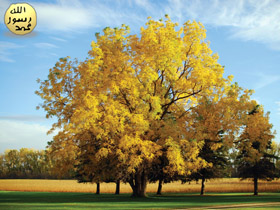And [I swear] by the night when it draws in, and by the dawn when it breathes in. (Qur'an, 81:17-18)
.jpg)
Light is one of the most essential elements in the performance of photosynthesis. Photosynthesis varies in proportion to the intensity and duration of the light source. With the reception of the Sun’s rays in the morning, photosynthesis—in other words, the production of oxygen begins.
When plants undergo photosynthesis, they take in carbon dioxide, a harmful gas that human beings cannot consume, from the air, and give off oxygen instead. Oxygen, which we breathe and which is our basic source of life, is the main product of photosynthesis. Some 30% of the oxygen in the atmosphere is produced by plants on land, the remaining 70% being produced by plants and single-celled living things in the seas and oceans.
Photosynthesis is a complex process, and one which scientists have still not yet fully understood. This process cannot be observed with the naked eye, because the mechanism employs, atoms and molecules. However, we can see the results of photosynthesis in the oxygen which enables us to breathe, and in the foodstuffs that keep us alive. Photosynthesis is a system which involves complicated chemical formulae and units of weight, and on very small scale, and consisting of the most sensitive equilibriums. There are trillions of chemical laboratories that carry out this process in all the green plants around us. Furthermore, plants have been meeting our oxygen, food and energy needs non-stop for millions of years.
The productivity of photosynthesis is measured by the level of oxygen output. The greatest point is in the morning, when the Sun's rays are most concentrated. At dawn, the leaves begin to sweat, and photosynthesis increases accordingly. In the afternoon, however, the opposite applies; in other words photosynthesis slows down, and respiration increases because as the temperature rises perspiration also increases. At night, as the temperature falls, perspiration declines and the plant rests.
The term "itha tanaffasa" in Surat at-Takwir, in reference to the morning hours, in other words, "when it breathes in," is a metaphorical reference to breathing, respiration, or breathing deeply. This term particularly emphasises the way that the production of oxygen begins in the morning, and that the greatest levels of oxygen, essential for respiration, are given off at that time. The importance of the phenomena is also emphasised by the way that Allah swears upon it. The way that Allah indicates the action of photosynthesis, among the most important discoveries of the 20th century, in this verse, is another of the scientific miracles of the Qur'an.

Photosynthesis is the use by plants and sometimes by certain bacteria and single-cell life forms of the Sun’s rays in order to produce sugar (carbohydrate) from carbon dioxide and water. As a result of this reaction, the energy in the Sun’s rays is stored inside the sugar molecule produced. The following formula summarises the reaction that takes place during the process by which unusable solar energy is transformed into usable chemical energy:
6H2O + 6CO2 ---PHOTOSYNTHESIS---> C6H12O6+ 6O2
(6 water molecules + 6 carbon dioxide molecules are turned into 1 sugar molecule and 6 oxygen molecules by means of photosynthesis.)


